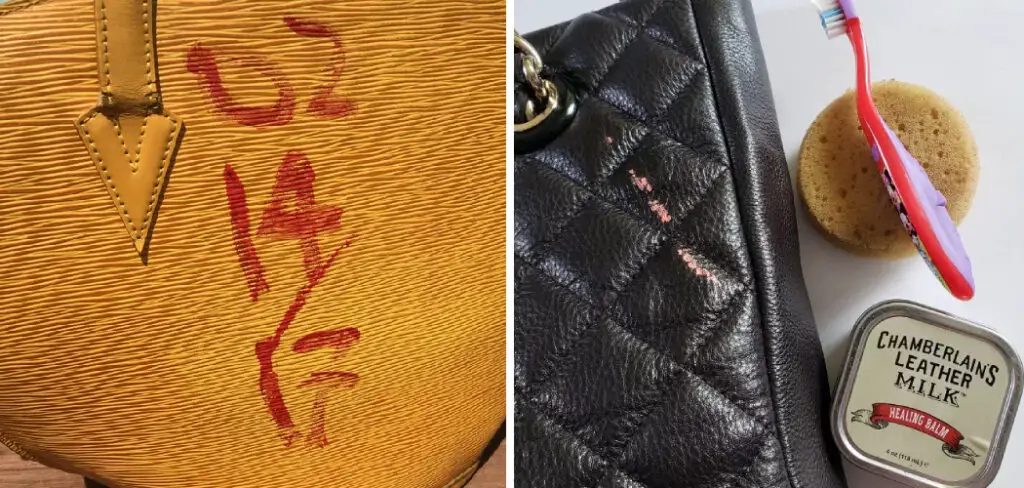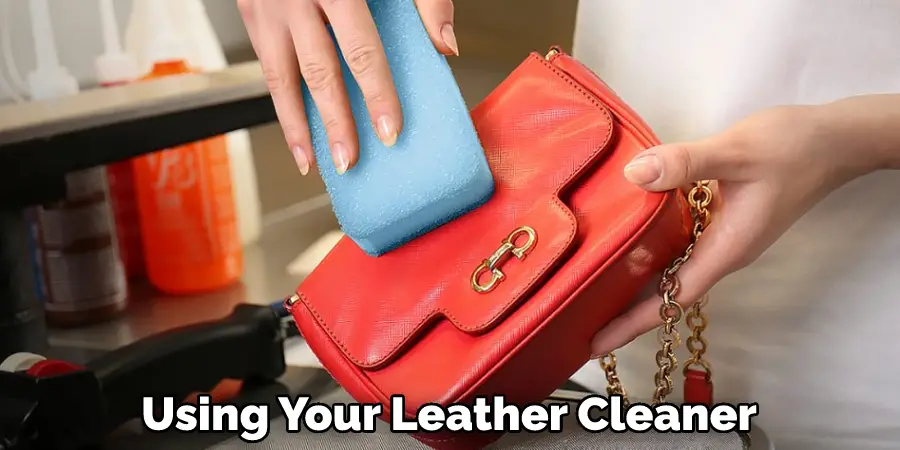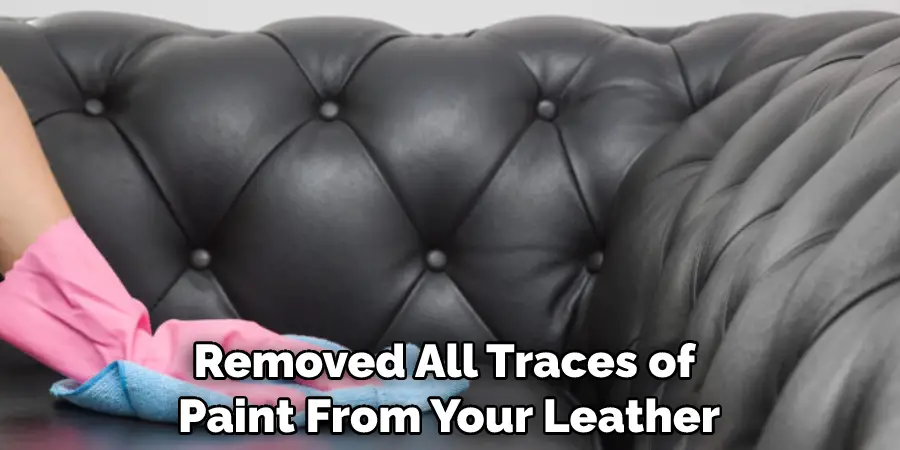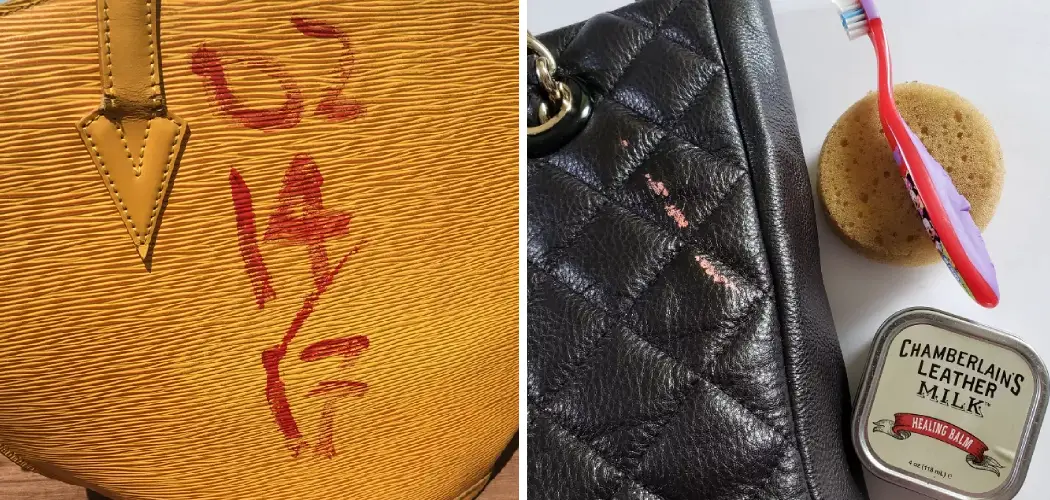Are you looking for a way to remove paint from your leather goods? Whether you are trying to clean up a spill or get an old piece of furniture ready for repurposing, effective solutions can help you get the job done.

Leather furniture is a popular choice for many homes because it is stylish and durable. Over time, however, paint can accumulate on the surface of the leather, making it look unsightly.
It’s not always easy to remove paint from leather, but it can be done with the right tools and techniques. This blog post will show you how to remove paint in leather using several methods. So if you’ve got a painting project that left paint on your leather product, keep reading for our advice on how to get it cleaned up quickly and safely.
What Will You Need?
You will need a few basic tools and supplies to remove paint from the leather. Here are some of the items you may need for this project:
- Leather cleaner or saddle soap
- Ammonia
- A soft cloth or sponge
- Rubber gloves
With these tools at your disposal, you can start the process of removing paint from leather.
10 Easy Steps on How to Remove Paint in Leather
Step 1. Use Leather Cleaner:
Begin by washing the paint off of your leather surface with a specialized leather cleaner or saddle soap. Gently rub this solution into the leather using a soft cloth or sponge, and let it sit for a few minutes to help break down the paint. Be careful to avoid any areas where the leather may be cracked or damaged, as these solutions can cause further damage.
Step 2. Apply Ammonia:
Once you have removed most of the paint using your leather cleaner, take a small amount of ammonia and apply it directly to the remaining paint stains. Again, use a soft cloth or sponge to apply the ammonia and gently work it into the leather. Don’t be too aggressive, as this can damage the surface of your leather furniture.

Step 3. Scrub with a Sponge:
After letting the ammonia sit for several minutes, take a clean sponge or cloth and scrub at the paint stains to help loosen them from the surface of the leather. Continue working in small circles until you have removed as much of the paint as possible. If the paint is stubborn, reapply the ammonia and scrub again.
Step 4. Wipe Away Remaining Residue:
Once you have removed most of the paint using your scrubbing tools, use a damp cloth to wipe away any remaining residue or residue on hard-to-reach areas like crevices or seams.
Be sure to dry off your leather item completely before moving on to the next step. It’s also a good idea to check your leather item for any remaining paint or stains and repeat the cleaning process if necessary.
Step 5. Condition the Leather:
To help restore your leather item to its original condition and protect it from future damage, use a commercial leather conditioning product. Apply this solution according to the manufacturer’s instructions, and let it sit for several minutes before wiping away any excess liquid.
If you still notice some areas of paint on your leather surface after following these steps, simply repeat the process until all remnants have been removed.
Step 6. Use Heat If Necessary:
Finally, if you struggle to remove stubborn stains or large areas of paint from your leather item, consider using heat to help loosen them up. Gently apply a blow dryer or heat gun to the affected area, and wait until the paint bubbles or softens. This can help you break down the paint more easily, making it easier to scrub away.
You Can Check It Out to Clean a Leather Chair

Step 7. Protect Your Leather:
Once you have successfully removed all traces of paint, take steps to protect your leather item going forward. Consider using a protective coating or sealant on your furniture or other items to help prevent future damage and stains. Be careful to follow the manufacturer’s instructions for how much to use and how long to let it sit before wiping away any excess.
Step 8. Maintain Your Leather:
To keep your leather looking its best for many years to come, be sure to regularly clean and condition it according to the manufacturer’s guidelines. This will help prevent any new stains or paint buildup from occurring in the future. Also, keep your leather product looking beautiful for years to come.

Step 9. Seek Professional Help if Necessary:
If you find that your paint removal attempts are unsuccessful, or if your leather item is extremely damaged or stained, consider seeking professional help from a leather restoration expert. These professionals have the tools and experience to quickly and effectively remove paint from even the most delicate leather surfaces.
Step 10. Stay Safe:
Finally, always exercise caution when working with paints and other potentially hazardous materials. Wear protective gear, such as rubber gloves and safety glasses, at all times, and avoid using harsh chemicals or excessive heat that may damage your leather product further.
With these tips in mind, you can easily remove paint from your favorite leather items confidently!
You Can Check It Out to Clean Ink Marks on Leather
5 Additional Tips and Tricks
- Check the leather surface for any dents, scratches, or other signs of damage before you begin.
- Use a soft cloth to wipe away any loose or flaking paint gently.
- If the leather is still wet, allow it to dry fully before proceeding.
- Apply a small amount of gentle leather-safe soap to a damp cloth and gently scrub the area where the paint is located.
- Once you have removed all traces of paint from your leather surface, use a clean, soft cloth to gently buff the area until it is completely dry and free of streaks or residue.

While removing paint from leather can be challenging, with these tips and tricks, you should be able to restore your leather pieces to their original condition in no time!
5 Things You Should Avoid
1. Using Harsh Chemicals or Abrasive Tools
Using harsh chemicals or overly abrasive tools can damage the leather and make it harder to remove the paint from your leather items.
2. Using Excessive Force
Applying too much pressure while trying to remove the paint can also cause damage to your leather, so be sure to use gentle, consistent strokes when removing the paint.
3. Leaving Your Leather Untreated
If you leave your painted leather untreated without properly cleaning and drying it, you may risk staining or discoloration over time.
4. Using Too Much Water
It can be tempting to use lots of water when trying to remove the paint, but this can also damage your leather, so it’s best to use just enough water to clean away the paint effectively.
5. Trying to Remove Too Many Layers at Once
Removing multiple layers of paint from your leather in one go is likely to cause further damage and make the job more difficult than it needs to be. Instead, work slowly and carefully in stages until all traces of the paint are gone.
If you follow these tips while removing paint from your leather items, you should be able to remove any unwanted stains without damaging or discoloring your valuable leather pieces. Good luck!
Can You Use Nail Polish Remover on Leather?
There is no definitive answer to this question, as different types of leather may respond differently to nail polish remover. Generally speaking, it is not recommended that you use nail polish remover on leather, as the chemicals in this product can cause damage and discoloration to leather surfaces.
However, suppose you are dealing with a small area of paint or a relatively new stain. In that case, you may want to try using some mild nail polish remover on a soft cloth to see how your particular piece of leather reacts before trying more extensive or aggressive methods.
If you do decide to use nail polish remover on your leather item, be sure to test it out in an inconspicuous area first and exercise caution when applying it so that you do not accidentally damage the leather surface. And as always, it is best to consult a professional before trying any serious cleaning or restoration techniques on your leather products.
Frequently Asked Questions
Does Alcohol Remove Paint From Leather?
It depends on the type of alcohol and the paint. Acetone, ethanol, and isopropanol are all common types of alcohol, and they all have different effects on paint. Acetone is the most volatile of the three, which means it will quickly remove paint from leather. Ethanol and isopropanol are less volatile, so they will remove paint over a longer period of time but at a slower rate. Generally speaking, acetone is the best option for removing paint from leather, followed by ethanol and then isopropanol.
Can You Use Paint Thinner on Leather?
Yes, you can use paint thinner on leather. Paint thinner is a solvent that is used to dissolve the paint and wood adhesives that are used to bind the layers of paint and wood together. By using paint thinner on leather, you will be able to remove the paint and wood adhesives more easily, which will allow the leather to breathe and look neater. Always use caution when using any type of solvent on leather – it is important to use a small amount of paint thinner and to exercise caution when working with the leather so as not to damage it.
What is the Best Paint Remover for Leather?
There are a number of different paint removers available on the market, and each has its own unique features and benefits. Some of the more popular paint removers for leather include:
1. Leatherique: This product is designed to remove Paint, Lacquer, Preservative, Urethane, and other oils and residues from leather surfaces. It is safe to use on all types of leather, including cowhide, sheepskin, horsehide, and motorcycle leather.
2. Mr. Clean: Mr. Clean is a popular paint remover for both indoor and outdoor use. It is safe for use on both hardwood and laminate floors as well as most vinyl surfaces.
3. Simple Green: Simple Green is another effective paint remover that is safe for use on a variety of surfaces, including wood, plastic, vinyl, metal, and tile.
4. OO-Silicone: OO-Silicone is an all-natural paint remover that is safe for use on both indoor and outdoor surfaces. It also has a quick-drying formula that makes it easier to clean up after painting or cleaning.
5. Goo Gone: Goo Gone is a versatile paint remover that can be used on a variety of surfaces, including wood, plastic, vinyl, metal, and tile. It also has a quick-drying formula that makes it easier to clean up after painting or cleaning.
Which Oil is Used for Removing Paint?
The type of oil used for removing paint depends on the paint and surface being treated. Some common oils used for removing paint include mineral spirits, lacquer thinner, and carpenter’s oil. It is important to use the right type of oil for the job at hand, as incorrect usage may result in damage to the paint or surface. Always read the label before using any type of oil to remove paint, and be sure to wear safety gear such as gloves and a mask when working with volatile substances.
Conclusion
You have a few options available to you when it comes to removing paint from leather. Each method has its own set of pros and cons, so be sure to choose the one that best suits your needs. With a little patience and elbow grease, you’ll have that leather couch or handbag looking good as new in no time!
You should now have all the information you need to know about how to remove paint in leather. This is a difficult process, but it is possible with the right tools and knowledge.
Always be sure to test a small area before attempting to remove paint from your leather goods. If you have any questions or concerns, feel free to contact a professional for help.

